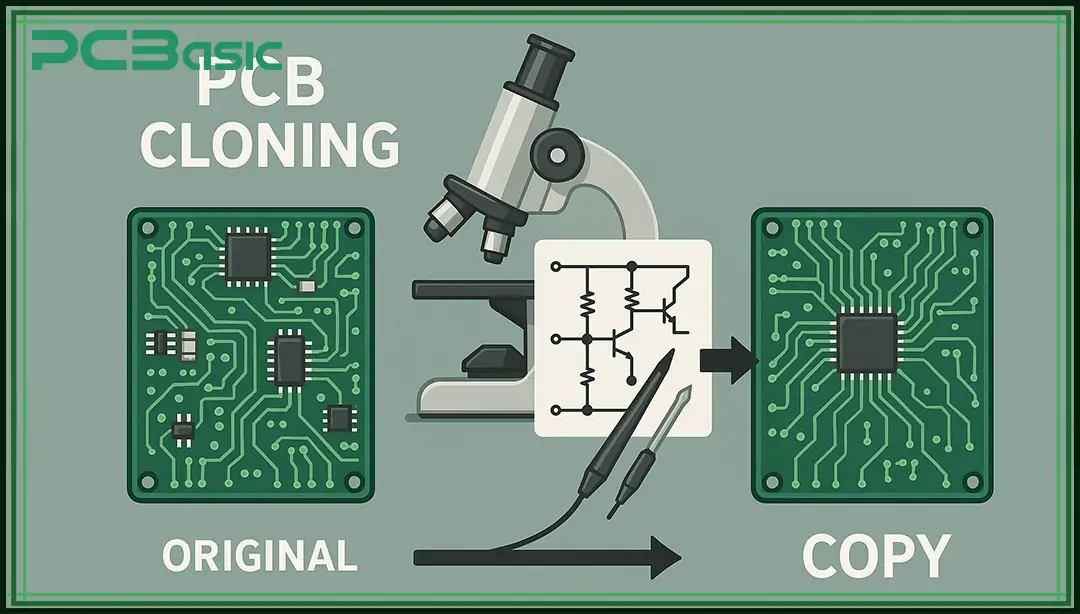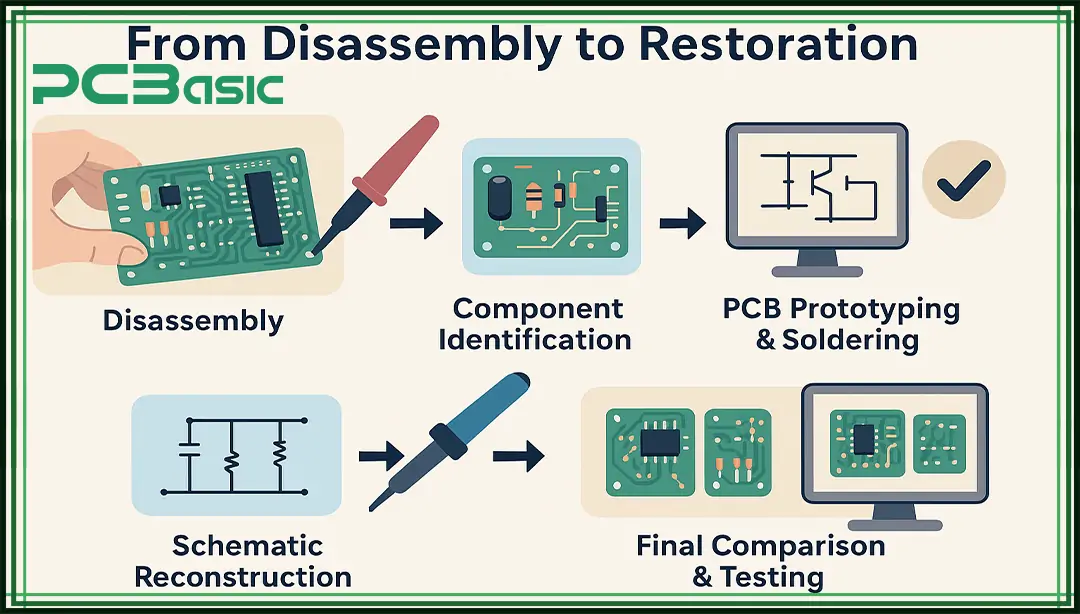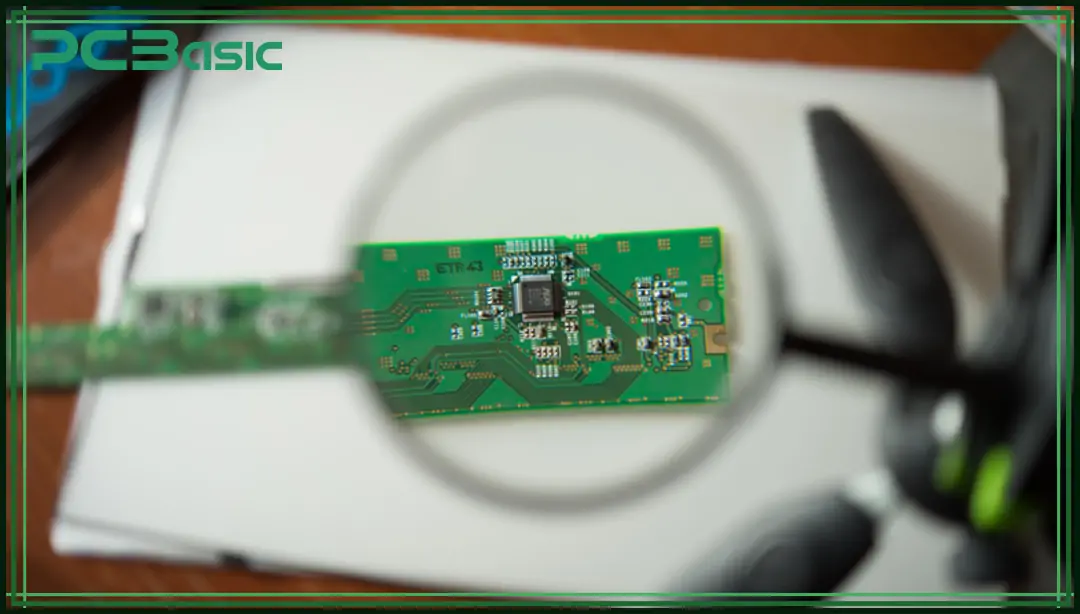Global high-mix volume high-speed Shenzhen PCBA manufacturer

Ru
9:00 -18:00, Mon. - Fri. (GMT+8)
9:00 -12:00, Sat. (GMT+8)
(Except Chinese public holidays)





Global high-mix volume high-speed Shenzhen PCBA manufacturer

Ru
9:00 -18:00, Mon. - Fri. (GMT+8)
9:00 -12:00, Sat. (GMT+8)
(Except Chinese public holidays)





HomePage > Blog > Knowledge Base > Choose PCBasic for Your PCB Cloning
In the process of product redesign, old circuit reproduction and competitive benchmarking, engineers commonly use PCB cloning. Whether you want to revive outdated hardware or optimize an existing board, PCB cloning is an efficient solution.
Keep reading to discover all about PCB cloning.

PCB cloning means taking an existing circuit board and recreating an identical one by disassembling, analyzing, and reverse-engineering it.
In simple terms, in the absence of original data, relying on the existing material, engineers can redraw the circuit, list the components used (BOM), and then make the production file (Gerber), and finally re-create the same function and appearance of the circuit board.
PCB cloning is particularly suitable for use when the original design data has been lost, or when the original manufacturer has discontinued production and no longer provides technical support. Through PCB cloning, the entire design can be restored for continued production, maintenance, or upgrading, which is now a commonly used and effective solution.
PCB cloning services aren’t just about “copying” circuit boards—they’re often chosen by businesses for practical reasons like saving costs, keeping old products running, improving quality, and more.
Some devices have been used for many years, and the original factory has long since stopped producing them. At the same time, design files such as schematics or BOM cannot be found, and even the original chip has been discontinued. At this time, as long as there is a physical board, it can be redrawn through PCB cloning technology to reproduce an identical circuit board, so that the equipment continues to work without changing the whole system.
2. Cost reduction:
Some circuit boards are designed too complex, or use materials that are not cost-effective, resulting in high production costs. Through cloning, engineers can optimize the circuit design by replacing components with more cost-effective alternatives, simplifying the layout, and reducing the number of layers, so as to reduce production costs and make products more competitive.
3. Quality improvement:
In cloning, engineers do not only copy the original design, but also check if there are any problems with the circuit and what can be designed better. For example, with more advanced chips, better anti-interference design, the product can be improved in performance, but also more stable and durable.
All in all, PCB cloning service is not just to "copy", but to help enterprises solve the problem of old products, save costs, improve performance, and even achieve an efficient way to upgrade functions.
PCB cloning is actually to "copy" a circuit board without the original design data. It can even be optimized on the basis of the original. The process of cloning a board is more rigorous, needing to step-by-step operation, and each step is inseparable from professional engineers and meticulous work.

1. Sample analysis:
Before cloning, the customer needs to provide a complete circuit board sample, preferably in working order. Engineers will first check the board to understand all of its properties, including what its function is, how many layers, how big it is, what components are used and so on. If the board is damaged, it will be repaired first to facilitate subsequent analysis.
2. High-resolution scanning:
Next, engineers scan the front, back, and each layer of the circuit board in high resolution, recording details such as wiring, pads, and holes. For multilayer boards, engineers need to disassemble layer by layer to take photos and record, ensuring that the structure of each layer is completely restored.
Using physical boards and scans, engineers analyze how the circuits are connected and redraw the entire circuit diagram. In this process, they not only copy the wiring, but also understand its working principle, ensuring that each function works properly.
4. BOM generation:
The components on the circuit board are identified one by one, including their model, package, electrical parameters, and then sorted into a standard bill of materials (BOM) for convenient procurement. If a component is found to be discontinued, engineers also recommend a new replacement.
5. Gerber and drill file creation:
Engineers redraw complete PCB drawings in PCB design software and generate Gerber files and drill files. These files are used for prototyping and producing circuit boards, and must be consistent with the original board.
6. Prototype testing:
Prototype a new board according to these files and then install components. After these steps, it’s time to do a variety of electrical tests and functional tests, checking if the cloned board is the same as the original function. If there is a problem, adjust and improve it until everything works.
7. Final delivery:
After the test is OK, engineers will send all the data, including schematic, BOM, Gerber, test report, to customers together with the sample. Customers can use this data to find a factory for production, or they can continue to ask engineers to help with mass production.
While PCB cloning is a powerful tool, it's important to understand the legal boundaries. PCB cloning should only be done when:
• The original design is not protected by active intellectual property rights.
• You own the rights or have permission from the board owner.
• You are cloning your own outdated design for which documentation has been lost.

When you want to repair, optimize, or reproduce a circuit board, it's important to find a reliable cloning service provider. With more than 15 years of PCB and PCBA production experience, PCBasic can provide you with high-quality one-stop PCB cloning services, which are widely used in industrial control, medical equipment, communications, automotive electronics, consumer electronics and other fields.
• Experienced Engineering Team
PCBasic’s engineers are familiar with various PCB types and structures. They can quickly dismantle the original board, extract schematics and BOM lists, and even optimize the design to improve performance and reliability.
• Advanced Equipment for Precise Replication
Equipped with high-precision scanners, X-ray systems, and automated analysis tools, PCBasic ensures complete and accurate data capture, with trace restoration accuracy of over 99%.
• Strong Manufacturing Capabilities
With 9 SMT production lines and complete DIP assembly and testing processes, PCBasic can quickly transition from cloning to prototyping and mass production, shortening lead times and improving efficiency.
• Strict Quality Control
Every cloned board undergoes multiple rounds of verification, including functional testing, electrical testing, flying probe testing, AOI, and X-ray inspections to ensure that the cloned board not only matches the original but performs even better.
• Guaranteed Confidentiality
PCBasic strictly enforces confidentiality agreements to protect your design files and business information, ensuring a secure and trustworthy process.
Whether you only have an old PCB sample or want to upgrade an existing product, PCBasic provides a full-service solution from circuit reverse engineering, ensuring original-level replication, better performance, and fast delivery.
Contact PCBasic today and let it breathe new life into your legacy projects and help you stay ahead in the market!

Assembly Enquiry
Instant Quote